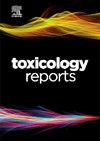Building a predictive model for polycyclic aromatic hydrocarbon dosimetry in organotypically cultured human bronchial epithelial cells using benzo[a]pyrene
Q1 Environmental Science
引用次数: 0
Abstract
The airway epithelium is a primary route of exposure for inhaled toxicants, and organotypic culture models represent an important advancement for toxicity testing compared to simple in vitro models that may lack metabolic capability and multicellular structure/communication associated with the bronchial epithelium in vivo. A quantitative understanding of chemical dosimetry is key for interpreting and extrapolating study results; however, dosimetry is understudied in organotypic models limiting ability to predict toxicity. We developed a dosimetry model for primary human bronchial epithelial cells (HBECs) cultured at the air-liquid interface (ALI) using benzo[a]pyrene (BAP), a representative polycyclic aromatic hydrocarbon. Dose and time course evaluation of metabolite formation and enzyme activity and expression were utilized to parameterize a cellular dosimetry model to improve the utility of ALI-HBECs for assessing chemical risk. Dosimetry analysis demonstrated absorption of BAP into cells and an increase in Phase 1 and 2 metabolites over time that correlated with regulation of metabolizing enzymes. BAP was cleared from cells by 48 h after exposure, and the primary metabolites generated in ALI-HBECs were BAP-3-phenol, BAP-4,5-dihydrodiol, BAP-7,8-dihydrodiol, BAP-9,10-dihydrodiol, BAP-7,8,9,10-tetrol, BAP-3-phenol-glucuronide, BAP-4,5-dihydrodiol-glucuronide, and BAP-9,10-dihydrodiol-glucuronide. The resulting dosimetry model described BAP and 7,8-dihydrodiol toxicokinetics in ALI-HBECs and suggested active excretion of 7,8-dihydrodiol. Overall, this study demonstrates metabolic competency of ALI-HBECs for BAP metabolism, demonstrates the usefulness of complex in vitro systems for human-relevant toxicity data, and exhibits how in silico models can be utilized for understanding the dosimetry of test compounds to aid in in vitro to human extrapolation of toxicity data for risk assessments.
用苯并[a]芘建立人支气管上皮细胞多环芳烃剂量学预测模型
气道上皮是吸入有毒物质的主要暴露途径,与简单的体外模型相比,器官型培养模型在毒性测试方面取得了重要进展,体外模型在体内可能缺乏与支气管上皮相关的代谢能力和多细胞结构/通讯。对化学剂量学的定量理解是解释和推断研究结果的关键;然而,剂量学在器官型模型中的研究不足,限制了预测毒性的能力。我们利用代表性的多环芳烃苯并[a]芘(BAP)建立了在气液界面(ALI)培养的原代人支气管上皮细胞(HBECs)的剂量学模型。利用代谢物形成的剂量和时间过程评估以及酶活性和表达来参数化细胞剂量学模型,以提高ALI-HBECs评估化学风险的效用。剂量学分析表明BAP被细胞吸收,随着时间的推移,1期和2期代谢产物增加,这与代谢酶的调节有关。暴露后48 h, BAP被细胞清除,ALI-HBECs产生的主要代谢产物为BAP-3-苯酚、BAP-4,5-二氢二醇、BAP-7,8-二氢二醇、BAP-9,10-二氢二醇、BAP-7,8,9,10-四醇、BAP-3-苯酚-葡萄糖醛酸盐、BAP-4,5-二氢二醇-葡萄糖醛酸盐和BAP-9,10-二氢二醇-葡萄糖醛酸盐。由此建立的剂量学模型描述了BAP和7,8-二氢二醇在ALI-HBECs中的毒性动力学,并表明7,8-二氢二醇有活性排泄。总的来说,本研究证明了ALI-HBECs对BAP代谢的代谢能力,证明了复杂的体外系统对人类相关毒性数据的有用性,并展示了如何利用计算机模型来理解测试化合物的剂量学,以帮助在体外推断人类毒性数据以进行风险评估。
本文章由计算机程序翻译,如有差异,请以英文原文为准。
求助全文
约1分钟内获得全文
求助全文
来源期刊

Toxicology Reports
Environmental Science-Health, Toxicology and Mutagenesis
CiteScore
7.60
自引率
0.00%
发文量
228
审稿时长
11 weeks
 求助内容:
求助内容: 应助结果提醒方式:
应助结果提醒方式:


